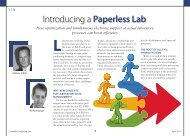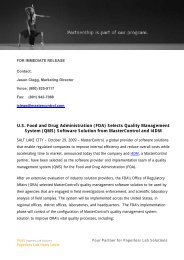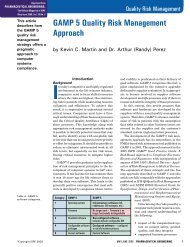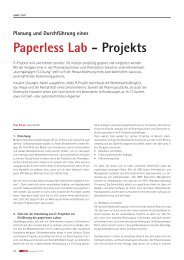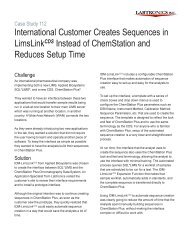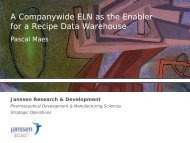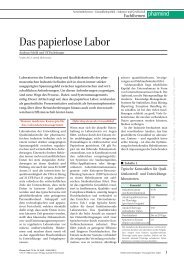The Paperless Lab - Vialis
The Paperless Lab - Vialis
The Paperless Lab - Vialis
Create successful ePaper yourself
Turn your PDF publications into a flip-book with our unique Google optimized e-Paper software.
<strong>The</strong> <strong>Paperless</strong> <strong>Lab</strong><br />
Andreas Schild and Dr. Ulf Fuchslueger<br />
<strong>Vialis</strong> AG, Liestal, Switzerland<br />
Pharm. Ind. 73, Nr. 12, 1 – 4 (2011)<br />
© ECV • Editio Cantor Verlag, Aulendorf (Germany)<br />
Arzneimittelwesen • Gesundheitspolitik • Industrie und Gesellschaft<br />
Fachthemen<br />
<strong>Lab</strong>oratories working in the pharmaceutical industry in the areas of<br />
R&D and quality control find themselves increasingly having to cope<br />
with conflicting demands – tougher regulatory requirements and<br />
harsher economic realities. In order to meet these demands, new<br />
ways of dealing with process-, data- and system management are<br />
necessary. This article shows how the paperless lab (as an integrated<br />
process, not as a system implementation) can meet these challenges<br />
and boost efficiency.<br />
Why new concepts for<br />
laboratory data management?<br />
<strong>Lab</strong>oratories working in the pharmaceutical<br />
industry in the areas of<br />
R&D and quality control find themselves<br />
increasingly having to cope<br />
with conflicting demands – tougher<br />
regulatory requirements and harsher<br />
economic realities. On the one hand,<br />
the authorities require more data<br />
with more quality, such as with the<br />
new EU GMP Annex 11 and the more<br />
intensive FDA inspections regarding<br />
21 CFR Part 11. On the other hand,<br />
there are the commercial pressures<br />
requiring more data in less time,<br />
typically with the same level of staff<br />
or less. On top of that, advances in<br />
technology and laboratory equipment<br />
mean that ever more data is being<br />
generated faster – which creates<br />
almost insurmountable obstacles for<br />
conventional documentation- and<br />
data-management processes in regulated<br />
laboratories, in turn causing<br />
bottlenecks for the development and<br />
approval processes.<br />
<strong>The</strong> root of all evil: hybrid<br />
systems<br />
When you look at data management<br />
in the lab, what you usually see is a<br />
mixture of various independent, nonintegrated<br />
data-processing systems<br />
on paper and in electronic form.<br />
Often paper is the preferred documentation<br />
medium when you have<br />
a mix of countless computerized<br />
systems such as analyzers, office applications<br />
and upper-level systems,<br />
for example, laboratory-information<br />
management or enterprise-resourceplanning<br />
(ERP) systems. Such a scenario<br />
results in producing a hybrid<br />
system with numerous media gaps<br />
– this is the real root of all evil, leading<br />
to inefficiencies, quality and compliance<br />
risks and unnecessarily long<br />
throughput times which prevent<br />
businesses from hitting their targets.<br />
Table 1 shows the typical key performance<br />
indicators of such a laboratory.<br />
<strong>The</strong> high level of quality risk (due<br />
to the high number of manual data<br />
transcription steps) is countered<br />
with extensive control steps – but<br />
that results in less efficiency and<br />
longer throughput times. <strong>The</strong> use of<br />
isolated systems prevents the timely<br />
transfer of information, which leads<br />
to further unforeseeable delays and<br />
additional costs.<br />
And last, but not least, it can result<br />
in a considerable amount of the<br />
enterprise’s intellectual capital being<br />
wasted. <strong>The</strong> cost of using various isolated<br />
systems to collect data for modern<br />
knowledge-management systems<br />
(statistics, data mining, reporting, exception<br />
handling, etc) is simply too<br />
high. So much knowledge that could<br />
be extracted from the data collected<br />
remains untapped.<br />
In the industry, there are three different<br />
approaches to addressing this<br />
root problem. <strong>The</strong> first – and actually<br />
no real solution – is the optimization<br />
of the existing hybrid system<br />
by adapting the existing processes<br />
and systems. It goes without saying<br />
that such an approach only brings<br />
selective and slight improvements.<br />
<strong>The</strong> second is the introduction of<br />
electronic documentation systems<br />
(often described as electronic lab<br />
notebooks) that show the paper data<br />
in electronic format. While the introduction<br />
of such a system brings<br />
certain benefits for quality and compliance<br />
purposes, the real problem is<br />
simply transferred from paper to an<br />
electronic format (“paper on glass”)<br />
■■Table 1<br />
English reprint of the<br />
German original publication<br />
Typical key performance indicators<br />
(KPI) for quality control and<br />
development laboratories.<br />
KPI Value<br />
Effort documentation 45 %<br />
and control<br />
Number of quality- 100<br />
relevant transfers<br />
(per approved batch)<br />
Number of redundant 250<br />
data transfers<br />
Process time up to 20 days<br />
Systems in operation 10<br />
(paper and electronic)<br />
With the exception of the documentation and<br />
control effort, all numbers refer to the approval or<br />
analysis of one batch. Quality-relevant transfers<br />
have a direct impact on the result; redundant data<br />
transfers provide references and cross-references.<br />
Schild and Fuchslueger • <strong>The</strong> <strong>Paperless</strong> <strong>Lab</strong> 1<br />
lFor use with permission of the publisher l
lFor use with permission of the publisher l<br />
Arzneimittelwesen • Gesundheitspolitik • Industrie und Gesellschaft<br />
Fachthemen<br />
and the hoped for gains in efficiency<br />
are only very small. And the practicality<br />
of introducing electronic documentation<br />
into the laboratory (using<br />
tablet-PCs or other mobile devices)<br />
is highly questionable. <strong>The</strong> third approach,<br />
which we discuss in more<br />
detail below, is the optimization and<br />
simultaneous electronic support of<br />
the actual laboratory processes – the<br />
introduction of the paperless lab.<br />
<strong>The</strong> way to a paperless<br />
laboratory<br />
Since introducing a paperless laboratory<br />
involves more than simply implementing<br />
another IT application,<br />
the procedure model we use here<br />
takes into account other perspectives<br />
in order to build a sustainable<br />
overall concept. <strong>The</strong>se perspectives<br />
fall into three main areas – the business<br />
needs, the user’s needs and the<br />
technical perspective.<br />
<strong>The</strong> business point of view defines<br />
the project’s goals and vision and<br />
ensures that the introduction of the<br />
paperless laboratory complements<br />
the company’s overall business objectives.<br />
Typical goals for producers<br />
are increasing net cash flow, reducing<br />
development time and thereby<br />
generating additional sales or reducing<br />
warehousing and stock costs<br />
to free up more capital. Naturally,<br />
various other goals or combinations<br />
of targets are possible – but what is<br />
decisive is that a quantitative connection<br />
can be made between laboratory<br />
activities and business objectives.<br />
This is achieved by defining a<br />
business-specific cause-effect model<br />
and implementing it into a corresponding<br />
financial model [1]. That is<br />
the only way that you can ensure that<br />
the implementation project meets<br />
the company’s targets and that the<br />
cost-benefit analysis accounts for all<br />
relevant factors.<br />
<strong>The</strong> user’s point of view is the<br />
central element to developing the<br />
paperless laboratory concept. Based<br />
on a thorough process- and system<br />
analysis, the user’s perspective will<br />
be summarized in the form of process<br />
descriptions and data-streams.<br />
Apart from the actual laboratory pro-<br />
2 Schild and Fuchslueger • <strong>The</strong> <strong>Paperless</strong> <strong>Lab</strong><br />
cedures – such as sample flow and<br />
processing – supporting processes<br />
will also be mapped (such as apparatus<br />
maintenance, reference substance<br />
management and reagents in<br />
actual state). For every process step,<br />
information will be collected from<br />
any systems used, any responsibility<br />
changes and any data inputting and<br />
outputting. Key performance indicators<br />
will be collected from the process<br />
analysis for later integration into<br />
the financial model. Vital interfaces<br />
with upper-level processes will be analyzed<br />
and documented. <strong>The</strong> analysis<br />
process is also the foundation for the<br />
subsequently conducted multi-moment<br />
analysis – a methodology that<br />
allows quantitative information to be<br />
derived from and for processes.<br />
Multi-moment analysis [2, 3] provides<br />
statistically sound and accurate<br />
information about the use of resources<br />
per process step or sub-step – and<br />
for all processes. To collect data,<br />
every laboratory worker is equipped<br />
with a mobile device or PDA (configured<br />
for their particular tasks) that<br />
requires them periodically, but randomly<br />
(on average every 20 minutes)<br />
to select the task they are currently<br />
performing from a list. <strong>The</strong> impact of<br />
multi-moment analysis on the workflow<br />
is minimal because just a simple<br />
click suffices – no recording of times<br />
or other parameters is required. Over<br />
a typical period of two weeks, sufficient<br />
data is collected to enable<br />
highly detailed statistic analyses to<br />
■■Figure 1<br />
be made on costs, time and clustering<br />
for processes, process steps and<br />
task categories. Figs. 1 – 3 show examples<br />
of various evaluations from<br />
a multi-moment analysis. <strong>The</strong> multimoment<br />
analysis not only allows<br />
processes (independent of whether<br />
a new system is introduced or not)<br />
to be optimized where the greatest<br />
need or benefit lies, but also permits<br />
the work stages to be categorized –<br />
thereby enabling a quantitative assessment<br />
of the potential benefits<br />
that the implementation of a paperless<br />
lab would bring (see Fig. 3). That,<br />
in turn, provides the foundation for a<br />
fact-based business case and for the<br />
comparison of various implementation<br />
scenarios and their economic<br />
benefits. <strong>The</strong> qualitative process description<br />
(together with the key performance<br />
indicators and quantitative<br />
statements from the multi-moment<br />
analysis) thus provides the crucial<br />
information for the paperless laboratory<br />
concept development.<br />
Taking the technological (i. e. IT<br />
and equipment) point of view – and<br />
looking at the existing infrastructure,<br />
company standards and long-term<br />
strategy – enables a comprehensive<br />
concept to be developed for the automation<br />
of the laboratory data-flow<br />
process. Only then will such a concept<br />
be in line with the company’s<br />
commercial targets.<br />
To develop the paperless lab concept<br />
– as well as considering the<br />
three perspectives outlined above –<br />
Distribution of tasks for a specific laboratory process as a percentage of work hours.<br />
<strong>The</strong> colors display the categorization in 4 categories; the documentation and control<br />
categories could be substantially reduced by the introduction of a paperless laboratory.<br />
Pharm. Ind. 73, Nr. 12, 1 – 4 (2011)<br />
© ECV • Editio Cantor Verlag, Aulendorf (Germany)
■■Figure 2<br />
Distribution of non-process activities per department as a percentage of work hours.<br />
■■Figure 3<br />
Aggregate values for all process and non-process activities for five different categories<br />
per department and as a total amount. <strong>The</strong> documentation and control categories<br />
show the potential of the introduction of a paperless laboratory.<br />
you also need a set of principles that<br />
allow for a definition of process targets<br />
based on the process description<br />
of the actual-state processes.<br />
<strong>The</strong> key principle and the vision of<br />
the paperless lab is the self-documenting<br />
process – a process that<br />
produces GxP-compliant documentation<br />
and eliminates unnecessary<br />
tasks from the workflow. That naturally<br />
means that manual data collection<br />
and transfer are eliminated<br />
wherever possible by interfacing to<br />
and from devices and systems – and<br />
where that is not feasible, by using<br />
barcodes for fast, error-free data<br />
collection. That also means that<br />
redundant or fragmented data is<br />
eliminated, that the “single-sourceof-truth”<br />
principle is implemented<br />
and that data is available to every<br />
authorized user in real-time. That,<br />
in turn, leads to improved process-<br />
es, faster decision-making and better<br />
teamwork.<br />
<strong>The</strong> application of these principles<br />
to the actual-state processes enables<br />
target-processes to be defined and<br />
functional requirements to be established.<br />
As part of the paperless lab<br />
concept, the delta between the current<br />
functionality and the required<br />
functionality will be generated in the<br />
gap-analysis. This is the only way the<br />
filling of such gaps may be conceptually<br />
approached – naturally always<br />
considering the underlying business<br />
targets. Possible scenarios also include<br />
the modification of existing<br />
IT systems by adapting existing applications<br />
to close functional gaps<br />
and multiple scenarios to close the<br />
remaining gaps with other applications.<br />
Once the only kind of application<br />
specifically aimed at laboratory<br />
use was a laboratory-information-<br />
management system (LIMS), but<br />
today there are many types of applications<br />
providing overlapping functionality.<br />
For example, electronic laboratory<br />
journals (ELN), sometimes<br />
for quality control referred to as laboratory<br />
execution systems or LES (derived<br />
from manufacturing execution<br />
systems or MES); archiving or rawdata<br />
management systems (scientific<br />
data management system or SDMS);<br />
specialized applications for device<br />
and system integration, increasingly<br />
also software that was not originally<br />
laboratory-specific, such as productlifecycle-management<br />
(PLM) systems<br />
or ERP systems. Some software<br />
firms also offer combinations of the<br />
above-named applications and there<br />
is generally a trend towards an extension<br />
and overlapping of functions<br />
or convergence of applications.<br />
<strong>The</strong>re is no quick answer as to which<br />
application combination is the best<br />
for a company. But by using SWOT<br />
analysis (strengths, weaknesses, opportunities<br />
and threats) to compare<br />
the various possible combinations<br />
– naturally accounting for the overall<br />
business targets and not just the<br />
needs of the laboratory – the selection<br />
can be reduced to one or two<br />
scenarios.<br />
<strong>The</strong> next step is to select suitable<br />
products to fit the desired application<br />
combination for the developed<br />
scenario. With a sound concept, defined<br />
target processes and their functional<br />
requirements, that is a relatively<br />
easy undertaking. As well as the<br />
functional considerations, it is also<br />
necessary to consider the complexity<br />
of the IT landscape and soft factors,<br />
such as the readiness of the software<br />
suppliers to cooperate.<br />
Before making any final selection<br />
– and to clear up any technical issues<br />
and to get prospective users involved<br />
at an early stage – it is recommended<br />
piloting the whole solution in small,<br />
well defined stages. Such a pilot<br />
scheme – which costs little in terms<br />
of money and risk – should cover as<br />
many areas of the paperless laboratory<br />
as possible and helps fine-tune<br />
the final implementation planning.<br />
<strong>The</strong> implementation of the final solution<br />
is made in accordance with<br />
Pharm. Ind. 73, Nr. 12, 1 – 4 (2011)<br />
© ECV • Editio Cantor Verlag, Aulendorf (Germany) Schild and Fuchslueger • <strong>The</strong> <strong>Paperless</strong> <strong>Lab</strong> 3<br />
lFor use with permission of the publisher l
lFor use with permission of the publisher l<br />
Arzneimittelwesen • Gesundheitspolitik • Industrie und Gesellschaft<br />
Fachthemen<br />
widely accepted standards, such as<br />
GAMP ® [4]. Because the pharmaceutical<br />
industry is so highly regulated,<br />
the whole system must be validated<br />
to meet strict requirements [5, 6]. <strong>The</strong><br />
work invested in the procedure model<br />
(e. g. process analysis, concept development,<br />
setting target processes and<br />
piloting) pays off here, contributing<br />
towards the necessary documentation.<br />
It should not be forgotten at this<br />
point that the paperless laboratory is<br />
not just the introduction of a system,<br />
but is also – above all else – process<br />
re-engineering. It is therefore necessary<br />
to support the new optimized<br />
process landscape with all necessary<br />
standard operating procedures<br />
(SOPs) and guidelines to maximize<br />
the benefits of the paperless laboratory.<br />
Faster, more precise<br />
and more economic<br />
Because of its integrated and process-oriented<br />
approach, the benefits<br />
of the paperless laboratory compared<br />
to using a specific application<br />
(such as an ELN) are several factors<br />
higher. <strong>The</strong> automation of the data<br />
flow and the continued elimination<br />
of documenting and related control<br />
activities significantly boost efficiency<br />
for laboratory staff and management.<br />
Already through these effects<br />
4 Schild and Fuchslueger • <strong>The</strong> <strong>Paperless</strong> <strong>Lab</strong><br />
alone, efficiency gains of 20 – 30 % are<br />
feasible (depending on a company’s<br />
situation). Additionally, the virtual<br />
elimination of manual tasks substantially<br />
reduces processing times<br />
and quality risk. System-specific automatic<br />
checks ensure compliance<br />
and data consistency reduce control<br />
activities to atypical results (“review<br />
by exception”), thereby accelerating<br />
processes and improving resource<br />
allocation. Since automatic documentation<br />
also automatically generates<br />
numerous process-relevant<br />
parameters – such as throughput<br />
times for certain tasks, equipment<br />
utilization or sample logistics – there<br />
is an excellent source of data for laboratory<br />
management. <strong>The</strong> paperless<br />
laboratory delivers key performance<br />
indicators for its own continual<br />
improvement, free of charge – and<br />
enables the comparison of organizational<br />
units using high quality<br />
data. And the availability of real-time<br />
data benefits other areas outside the<br />
laboratory – by simplifying interdepartmental<br />
cooperation, supporting<br />
knowledge management and improving<br />
follow-up processes. From<br />
the users’ point of view, the paperless<br />
lab substantially simplifies the workflow<br />
and reduces the number of systems<br />
implemented. It also supports<br />
user-specific portals and sharpens<br />
focus on what is important.<br />
It is clear that the sum of the paperless<br />
lab’s benefits is enormous. As<br />
with all investment projects of this<br />
size, after implementation, evidence<br />
should be presented to show that the<br />
estimated business case and reality<br />
correspond. This can be done at any<br />
time with the help of multi-moment<br />
analysis, which can also be used to<br />
quantify the impact of any process<br />
change on the workflow.<br />
■■ REFERENCES<br />
[1] Ritter J. Reducing Cost by Automating<br />
<strong>Lab</strong>oratory Workflow. G.I.T. <strong>Lab</strong>oratory<br />
Journal. 2009;13(7 – 8):32 – 34.<br />
[2] Haller-Wedel E. Das Multimomentverfahren<br />
in <strong>The</strong>orie und Praxis. Munich<br />
(Germany): Carl Hanser Verlag; 1969.<br />
[3] Simons B. Das Multimomentzeitverfahren,<br />
Grundlagen und Anwendung. Kologne<br />
(Germany): Verlag TÜV Rheinland<br />
GmbH; 1987.<br />
[4] ISPE: GAMP ® 5, a risk-based approach for<br />
GxP compliant computer systems; 2008.<br />
[5] Food and Drug Administration: 21 CFR<br />
Part 11.<br />
[6] EU-GMP Annex 11.<br />
Correspondence:<br />
Andreas Schild,<br />
<strong>Vialis</strong> AG,<br />
Kesselweg 40,<br />
4410 Liestal (Switzerland),<br />
e-mail: andreas.schild@vialis.ch<br />
Editor-in-chief: Claudius Arndt. Secretary’s office: Gudrun Geppert. Publisher: ECV ·Editio Cantor Verlag für Medizin und Naturwissenschaften GmbH, Baendelstockweg<br />
20, 88326 Aulendorf (Gemany). Phone: +49 (0) 75 25 94 00, Fax: +49 (0) 75 25 94 01 80. e-mail: redaktion@ecv.de. http://www.ecv.de. Production: stm media GmbH /<br />
druckhaus koethen GmbH, 06366 Koethen (Germany). All rights reserved.<br />
Pharm. Ind. 73, Nr. 12, 1 – 4 (2011)<br />
© ECV • Editio Cantor Verlag, Aulendorf (Germany)



